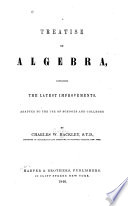 | Charles William Hackley - Algebra - 1846 - 544 pages
...j- — =- - =^= -- =. wblch B ^ — 5+ V21 2(5+ V21) 5+ -v/21 5+ reciprocal of the root . (3) Give the equation whose roots are the reciprocals of the roots of the equation Xs— S-r6— 2.^+ 3x3+1 Or3 +10*— 8 = 0. (4) Find the roots of the recurring equation 5y»_4y«+3y'-3y2... | |
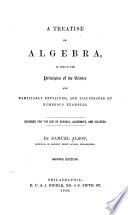 | Samuel Alsop - Algebra - 1848 - 336 pages
...28 —69 Ï5Ï 18 -92 46 -161 18 64 and the transformed equation is — 9 x* + 64 ar3 — 161 x" + 151 x — 23 = 0. 147. If the coefficients of the...original equation must therefore be of the form 1,1 1 . ' a, ~ ; b, r ; c, -, &c. а о с If the equation be of an odd degree, and the coefficients taken... | |
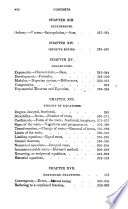 | Stephen Chase - Algebra - 1849 - 348 pages
...we'substitute - for x, we shall have if or, clearing of fractions, and reversing the order of the terms, an equation, whose roots are the reciprocals of the roots of the given equation. Hence, To transform an equation into another, whose roots shall be the reciprocals of the roots of... | |
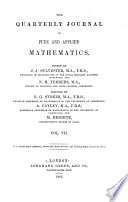 | Mathematics - 1866 - 426 pages
...+ Bi* must be positive. But this last equation is merely the first derived or limiting equation of the equation whose roots are the reciprocals of the roots of the reducing cubic; therefore it is twice positive when all the roots of the reducing cubic are real (and... | |
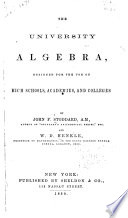 | John Fair Stoddard, William Downs Henkle - Algebra - 1859 - 538 pages
...2. Given a'— Qx' + Sx' + Sx1— 6* +1=0 to find all the values of x. Ant. -1, +1, +1, and 3. Find the equation whose roots are the reciprocals of the roots of the equation *'— Suf— 2x' + 3x' + 12*? + lQg— 8=0. Ant. 8y'— lOy'— 12y^-3^f 2y' + 3y-l=0. 4.... | |
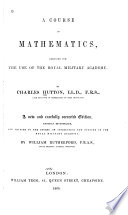 | Charles Hutton - Mathematics - 1860 - 1020 pages
...x in the proposed cquaу у tion, multiplying by y", and reversing the order of the terms, we have the equation whose roots are the reciprocals of the roots of the proposed equation. Cor. 1. Hence an equation may be transformed into another whose roots shall be greater... | |
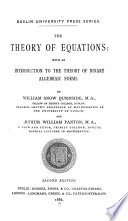 | William Snow Burnside, Arthur William Panton - Determinants - 1886 - 480 pages
...transformation x = 2 + -, we first employ the process of Art. 33, diminishing the roots by 2. We then find the equation whose roots are the reciprocals of the roots of the transformed. The equation in y is in this way found to be . y3 - 10ys - 6y - 1 = 0. This has a root... | |
 | William Snow Burnside, Arthur William Panton - Determinants - 1886 - 478 pages
...transformation x = 2 + -, we first employ the process of Art. 33, diminishing the roots by 2. We then find the equation whose roots are the reciprocals of the roots of the transformed. The equation in y is in this way found to be y3 _ 10y2 _ 6y - 1 = 0. This has a root between... | |
 | William Snow Burnside, Arthur William Panton - Determinants - 1886 - 474 pages
...transformation x — 2 + -, we first employ the process of Art. 33, diminishing the roots by 2. We then find the equation whose roots are the reciprocals of the roots of the transformed. The equation in y is in this way found to be yi _ 104,2 - 6y - 1 = 0. This has a root... | |
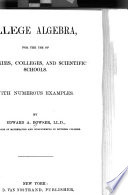 | Edward Albert Bowser - Algebra - 1888 - 868 pages
...x2 — 2x + 3 = 0. Ans. f ~ y + f = 0. 244. Problem III. — To transform an equation into another whose roots are the reciprocals of the roots of the given equation. Let f(x) = 0 be the given equation ; put y = -, so that x when x has any particular value, the value... | |
| |